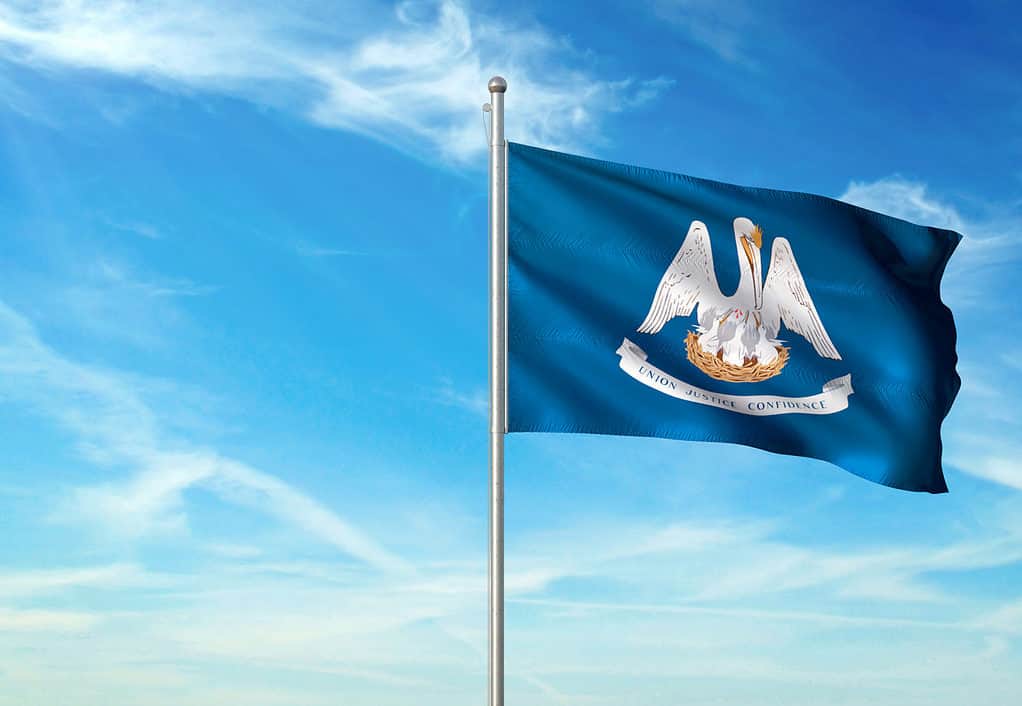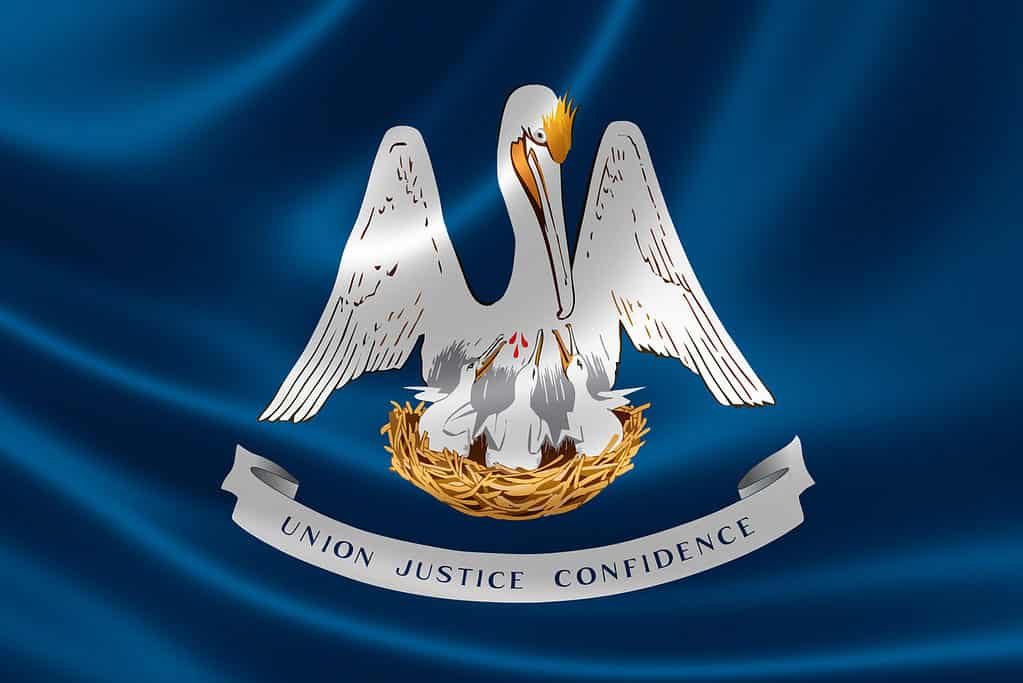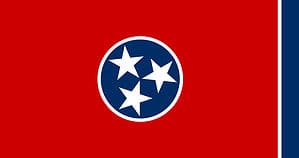Louisiana is a constituent state of the United States of America. The state is located in the deep south and south-central part of the country and is bordered by Texas to the west, Arkansas to the north, and Mississippi to the east. Louisiana was given its name in honor of Louis XIV, who ruled France from 1643 until 1715. The Latin suffix at the end of the state name, “-ana,” can be used to denote “knowledge connected to a specific person, subject, or place. As such, Louis + ana, thus, essentially conveys the sense of being “connected to Louis.”
The state is the 20th-smallest by area and the 25th most populous of the 50 U.S. states, with a total land area of 135,382 square kilometers (52,069.13 square miles) and almost five million inhabitants. The capital of Louisiana is Baton Rogue, and its largest city is New Orleans.
In this article, you will learn about the history, meaning, and symbolism of the flag of Louisiana.
When Was Louisiana as a State Founded?

Louisiana became the 18th state admitted to the Union in 1812.
©Sean Pavone/Shutterstock.com
The history of the region that is currently the state of Louisiana in the United States dates back thousands of years to the time when it was inhabited by native peoples. However, it was not established as a state until the 19th century, on April 30, 1812, when it was admitted as the 18th state of the United States. In 1682, the region was a part of the Kingdom of France, and in 1763, it was transferred to Spain before becoming a state. Louisiana was officially created following the Louisiana Purchase from France in 1803.
Between 1812 and 1861, during the Antebellum period, Louisiana was a predominant state in the use and trade of enslaved people, with over 47% of the population at the time enslaved. However, the state went under reconstruction between 1865 to 1877, and while the state was undergoing reconstruction, it was occupied by the U.S. Army as a component of the Fifth Military District.
Geography of Louisiana
Louisiana is a geographically diverse state, with the state being split into various regions, such as lowlands, hills, and terraces. Louisiana’s terrain is made up of comparatively flat lowlands that are situated on the alluvial plain of the Mississippi River and the coastal plain of the Gulf of Mexico. The state comprises five distinct geographic areas: the Coastal Marsh, the Mississippi Flood Plain, the Red River Valley, the Terraces, and the Hills, each playing important roles in the state. For instance, the Coastal Marsh, which separates land from the sea, comprises peat soils, fresh and saltmarsh vegetation, and serves as a natural boundary between the two. This allows the area to support the second-largest seafood industry in the United States by providing abundant fishing grounds.
Also, despite the Mississippi and Red rivers being very different and distinguished by soil and drainage differences, both rivers are still interconnected and provide a very efficient transportation system for Louisiana. This vast waterway, which runs near the Gulf of Mexico, contributes to Louisiana’s river system’s ability to act as a natural crossing point for the interchange of products made in the state and most of the midwest. The state is also home to many large lakes and oxbow lagoons, including Lake Ponchartrain.
The Climate of Louisiana
Generally, Louisiana’s climate is subtropical and characterized by long, hot, humid summers and short, moderate winters, particularly because of the state’s proximity to the Gulf of Mexico. The state is also impacted by continental weather patterns because it is situated at the mouth of the enormous Mississippi-Missouri river valley, nearly midway between the Atlantic and Pacific Oceans. The area is susceptible to hurricanes for at least six months in a year, from June through November. A portion of the state is also vulnerable to tornadoes in the early part of the year, and in the summer, the state also suffers from frequent thunderstorms.
Culture and Cuisine of Louisiana
In the same way that the state is home to diverse landscapes, it is also home to various cultures and ethnic groups. Because of its rich history, the state is a melting pot of different cultures. Some of the most prevalent cultures in the state include French, Spanish, and African; the first two being a result of the French and Spanish colonies that existed before Louisiana officially became a state and the latter being a result of the high population of enslaved people that once occupied the area. The state is renowned for its Creole culture, which combines elements of Native American, French, African, Spanish, and other European civilizations.
The impact of these different cultures can be witnessed in different parts of the state, but one of the most affected areas is the state’s cuisine. The most popular kind of cuisine in the state is Creole and Cajun. Creole cuisine, which first gained popularity in New Orleans in the early 1800s, is a combination of European, African, and Caribbean cooking methods employing products from Louisiana. Contrarily, Cajun cuisine was developed by French-Acadian exiles who landed in southwest Louisiana’s wetlands and plains during the 18th century. Another common food option in the state is seafood because of its thriving maritime industry, which is the second-largest in the United States.
History of the Flag of Louisiana

The flag of Louisiana was adopted in 1912.
©iStock.com/Oleksii Liskonih
The current flag, often referred to as the Pelican flag, was adopted on July 1, 1912. Louisiana has used the pelican as a symbol since the 1800s; in fact, one of the state’s nicknames is “The Pelican State.” Pelicans were considered to be kind birds by the early settlers in the region. Before the creation of the current flag, the state flew several flags, including one with a red canton and a single yellow star. This design featured the national colors of the United States, France, and Spain, who had formerly ruled Louisiana as colonial powers.
Flag of Louisiana: Meaning and Symbolism

The blue field on the flag of Louisiana represents truth.
©iStock.com/ronniechua
The state’s flag is a relatively simple design, with a rectangular blue field and the state’s official emblem at the center. Under the coat of arms is a white ribbon with the words “Union, Justice, and Confidence,” which is the state’s official motto. According to legends, the white pelican that serves as the centerpiece of the Louisiana coat of arms was thought to be so concerned about its young that when no other food was available, it would drain blood to feed them. The pelican hovering over its children and dripping blood symbolizes the sacrifices the state is willing to make for its people, and the blue field symbolizes truth.
Up Next:
The Flag of Argentina: History, Meaning, and Symbolism
The Flag of Namibia: History, Meaning, and Symbolism
The photo featured at the top of this post is © iStock.com/gladder
Thank you for reading! Have some feedback for us? Contact the AZ Animals editorial team.






